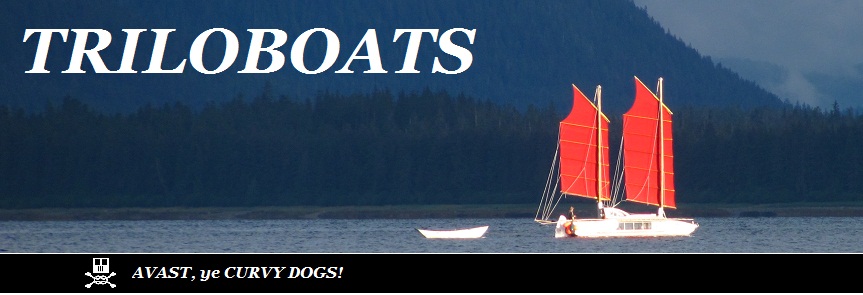MAITRE D' (to MR CREOSOTE): And finally, monsieur, a wafer-thin mint.
-- From Monty Phython's The Meaning of Life
The WAFER Dinghy Approach
Dinghies are indispensable to the cruising lifestyle.
When used to ferry us to and fro the shore, schlep our gear or while a pleasant afternoon away, they are fine and dandy things. But when we try to tow them, stow them, ship or unship 'em, or even lie quietly next to one of a flukey night... well... they can try a sailor's patience.
Partial solutions include dinghies which break-down, nest, inflate or fold for onboard stowage.
So, I been thinkin'...
So, I been thinkin'...
This partial solution - which I call the Wafer Dinghy approach - is a DIY, hard-shell folding type. Unlike most other folders I've seen, it folds flat. Bottom and sides are permanently joined, so getting ready for use is merely standing up the sides and inserting spreaders.
Here's the general recipe, borrowing heavily from Great Minds:
Here's the general recipe, borrowing heavily from Great Minds:
- Start with a heaping helping of Matt Layden's (brilliant) folding dinghy approach (ply panels with interlocking notches along chines (like interlocked fingers of two hands), tape n glued with 'canvas' bedded in elastomeric glue (e.g., polyurethanes, such as 3M5200, Sikaflex, etc)).
- Stir in a full measure of Phil Bolger's (brilliant) matched curvature between bottom and sides (reduces turbulence from cross-chine flow).
- Make height-of-Sides less than one half the Bottom beam, with sheer to taste.
- Season with favored 'folding dinghy transom method' at both ends (e.g., waterproof fabric with plank or stick spreaders).
- Bake in the harsh light of Reason until reasonably safe.
- Spread ends and mid-ships sections with plank seats or stick spreaders, and serve!
Since the side heights are less than half the bottom beam, they do not overlap when folded, and therefore lie completely flat. Since curves match, when folded flat, the bottom curve relaxes to flat, as well. As sides are stood up into position, their lower curve springs the bottom into shape.
Bottom shape may be either fully rockered, or have a mid-ships deadflat. To design, first lay out the flat Bottom, and use it to draw the Sides, super-imposed on the bottom. Consider that you'll lose some overall length to curvature when unfolded.
The approach can be applied to dinghies which range from short and beamy to long and slender.
My guess is that the interlocked notches along the chines that Matt Layden proposes aren't strictly necessary, unless subjected to very heavy use. But they are a brilliant solution, cheap and easy, and hedge one's bets.
Of course details would want to be kept to a minimum, in the spirit of a wafer. Rubrails, seats, oarlocks, etc... they all want to stow easily and flat, or they work against the grain.
One simplifying variation is to use more rocker and eliminate the end transoms (Side sheer will meet the corners of the Bottom). This might be useful for warm water paddling or as a backup against loss of a more capable tender.
A complicating variation is to split the Bottom down the centerline, tape n glue as chines, and fold like a W (end view). Possibly with an overlapping skeg of light strapping fixed to one side of the cut and spanning across to the other, forming a rabbet? The sprung bottom rocker resists spontaneous UNfolding in use, so no locks are necessary. The folded hull is now 4-ply, but only half the beam tall.
If you wish, the sheer need not be a straight line... this would allow relatively higher ends and relatively lower, mid-ships freeboard.
My guess is that the interlocked notches along the chines that Matt Layden proposes aren't strictly necessary, unless subjected to very heavy use. But they are a brilliant solution, cheap and easy, and hedge one's bets.
Of course details would want to be kept to a minimum, in the spirit of a wafer. Rubrails, seats, oarlocks, etc... they all want to stow easily and flat, or they work against the grain.
One simplifying variation is to use more rocker and eliminate the end transoms (Side sheer will meet the corners of the Bottom). This might be useful for warm water paddling or as a backup against loss of a more capable tender.
A complicating variation is to split the Bottom down the centerline, tape n glue as chines, and fold like a W (end view). Possibly with an overlapping skeg of light strapping fixed to one side of the cut and spanning across to the other, forming a rabbet? The sprung bottom rocker resists spontaneous UNfolding in use, so no locks are necessary. The folded hull is now 4-ply, but only half the beam tall.
If you wish, the sheer need not be a straight line... this would allow relatively higher ends and relatively lower, mid-ships freeboard.
In our yet-to be-completed prototype, we built in 1/4in ply, doubled along the sheer, and cut oarlocks into that. To date it lives, Wed behind our settee cushion waiting for a few hours to finish the ends and paint. An update is someday forthcoming.
*****
These would be light, quick to assemble, and relatively cheap and easy to stow. I could see a family cruiser with a 'short stack' of them; one for each family member. Folded, they can lie flat (stowed along superstructures, under solar panals(?) or against shrouds), parbuckled (inboard of leeboards?) or be sprung to deck camber.
We've not yet managed to finish one full-sized, though a second, on-board dinghy for the new boat would be nice!
We've not yet managed to finish one full-sized, though a second, on-board dinghy for the new boat would be nice!
If you do, you'll let me know?
 |
| Matt Layden with Dave and Mindy Boldav's Micro Folding Dinghy From MicroCruising.com. Note the light and partial rubrail. |


No comments:
Post a Comment